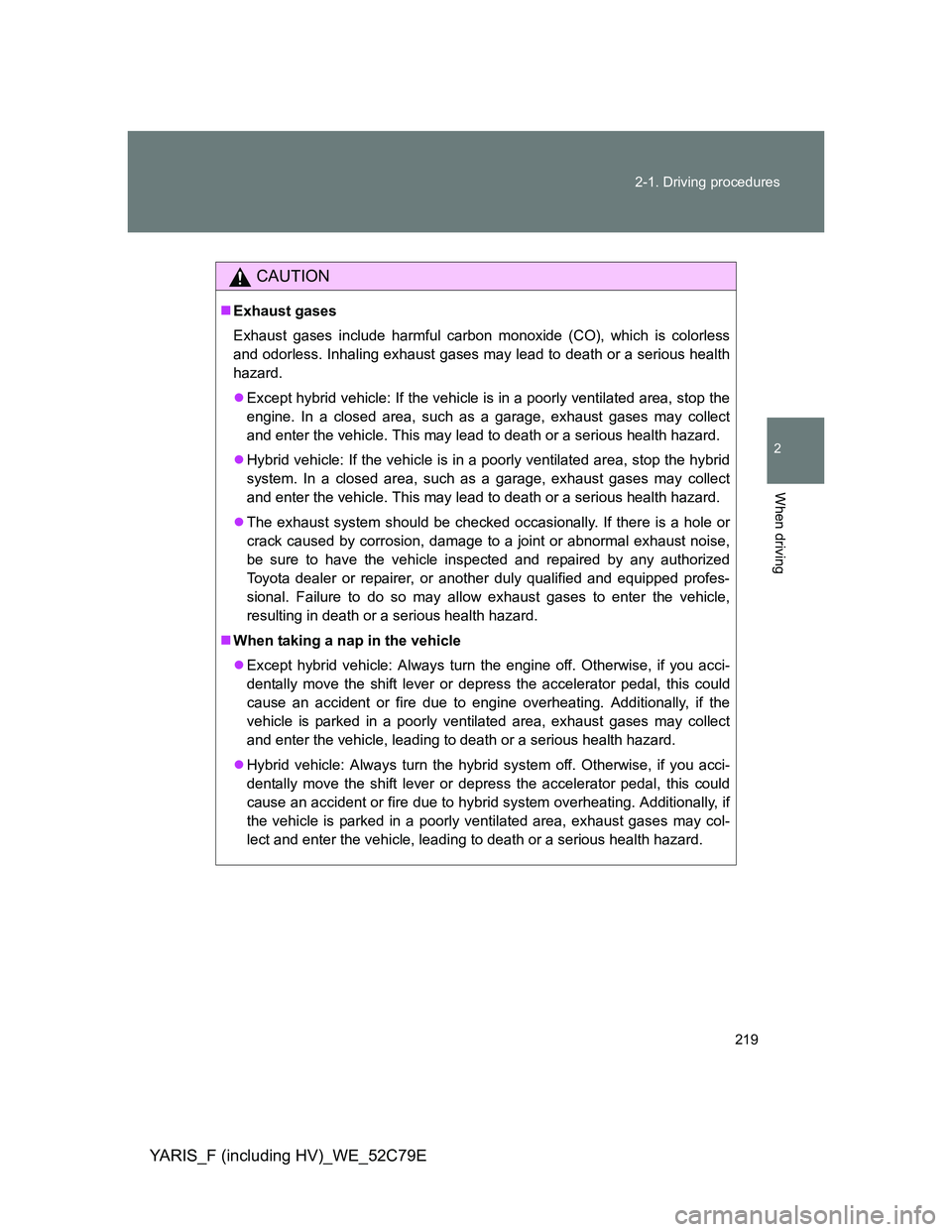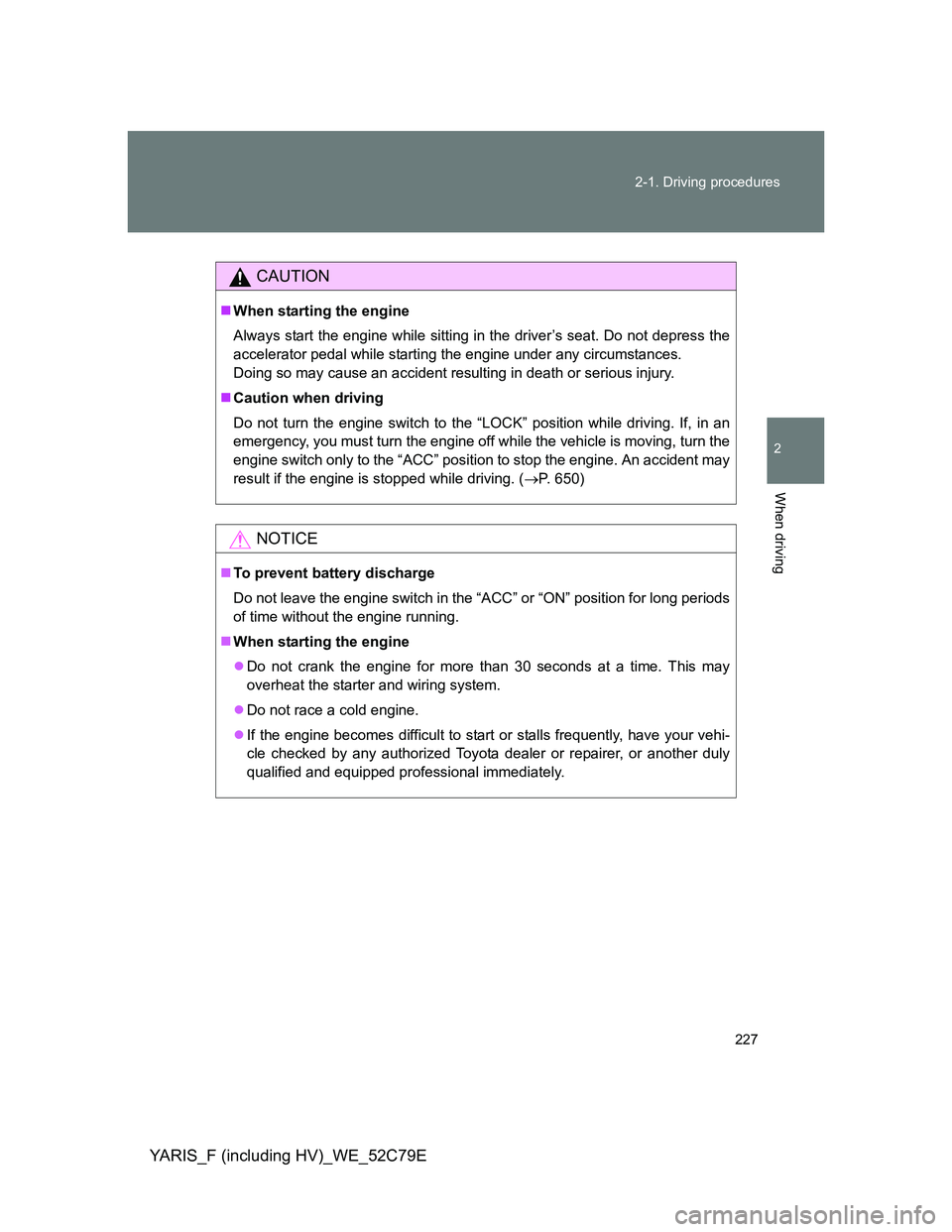Page 219 of 704

219 2-1. Driving procedures
2
When driving
YARIS_F (including HV)_WE_52C79E
CAUTION
Exhaust gases
Exhaust gases include harmful carbon monoxide (CO), which is colorless
and odorless. Inhaling exhaust gases may lead to death or a serious health
hazard.
Except hybrid vehicle: If the vehicle is in a poorly ventilated area, stop the
engine. In a closed area, such as a garage, exhaust gases may collect
and enter the vehicle. This may lead to death or a serious health hazard.
Hybrid vehicle: If the vehicle is in a poorly ventilated area, stop the hybrid
system. In a closed area, such as a garage, exhaust gases may collect
and enter the vehicle. This may lead to death or a serious health hazard.
The exhaust system should be checked occasionally. If there is a hole or
crack caused by corrosion, damage to a joint or abnormal exhaust noise,
be sure to have the vehicle inspected and repaired by any authorized
Toyota dealer or repairer, or another duly qualified and equipped profes-
sional. Failure to do so may allow exhaust gases to enter the vehicle,
resulting in death or a serious health hazard.
When taking a nap in the vehicle
Except hybrid vehicle: Always turn the engine off. Otherwise, if you acci-
dentally move the shift lever or depress the accelerator pedal, this could
cause an accident or fire due to engine overheating. Additionally, if the
vehicle is parked in a poorly ventilated area, exhaust gases may collect
and enter the vehicle, leading to death or a serious health hazard.
Hybrid vehicle: Always turn the hybrid system off. Otherwise, if you acci-
dentally move the shift lever or depress the accelerator pedal, this could
cause an accident or fire due to hybrid system overheating. Additionally, if
the vehicle is parked in a poorly ventilated area, exhaust gases may col-
lect and enter the vehicle, leading to death or a serious health hazard.
Page 223 of 704
223 2-1. Driving procedures
2
When driving
YARIS_F (including HV)_WE_52C79E
NOTICE
When encountering flooded roads
Do not drive on a road that has flooded after heavy rain etc. Doing so may
cause the following serious damage to the vehicle:
Engine stalling
Short in electrical components
Engine damage caused by water immersion
In the event that you drive on a flooded road and the vehicle is flooded, be
sure to have any authorized Toyota dealer or repairer, or another duly quali-
fied and equipped professional check the following:
Brake function
Except hybrid vehicle: Changes in quantity and quality of engine oil, trans-
mission fluid, etc.
Hybrid vehicle: Changes in quantity and quality of oil and fluid used for the
engine, hybrid transmission, etc.
Lubricant condition for the bearings and suspension joints (where possi-
ble), and the function of all joints, bearings, etc.
Page 224 of 704
224
2-1. Driving procedures
YARIS_F (including HV)_WE_52C79E
Engine (ignition) switch (except hybrid vehicle [vehicles without a smar t entr y & star t system])
Starting the engine
Vehicles with a Multidrive
Check that the parking brake is set.
Check that the shift lever is set in P.
Firmly depress the brake pedal.
Turn the engine switch to the “START” position to start the
engine.
Vehicles with a multi-mode manual transmission
Check that the parking brake is set.
Firmly depress the brake pedal, shift the shift lever to N.
(P. 260)
Turn the engine switch to “ON” position.
The indicator turns on.
After the indicator light goes out, turn the engine
switch to the “START” position to start the engine.
Vehicles with a manual transmission (gasoline engine)
Check that the parking brake is set.
Check that the shift lever is set in N.
Firmly depress the clutch pedal.
Turn the engine switch to the “START” position to start the
engine.
Page 225 of 704
225 2-1. Driving procedures
2
When driving
YARIS_F (including HV)_WE_52C79E
Vehicles with a manual transmission (diesel engine)
Check that the parking brake is set.
Check that the shift lever is set in N.
Firmly depress the clutch pedal.
Turn the engine switch to the “ON” position.
The indicator turns on.
After the indicator light goes out, turn the engine
switch to the “START” position to start the engine.
Changing the engine switch positions
“LOCK”
The steering wheel is locked
and the key can be removed.
(Vehicles with a Multidrive: The
key can be removed only when
the shift lever is in P.)
“ACC”
Some electrical components
such as the audio system can
be used.
“ON”
All electrical components can
be used.
“START”
For starting the engine.
Page 227 of 704

227 2-1. Driving procedures
2
When driving
YARIS_F (including HV)_WE_52C79E
CAUTION
When starting the engine
Always start the engine while sitting in the driver’s seat. Do not depress the
accelerator pedal while starting the engine under any circumstances.
Doing so may cause an accident resulting in death or serious injury.
Caution when driving
Do not turn the engine switch to the “LOCK” position while driving. If, in an
emergency, you must turn the engine off while the vehicle is moving, turn the
engine switch only to the “ACC” position to stop the engine. An accident may
result if the engine is stopped while driving. (P. 650)
NOTICE
To prevent battery discharge
Do not leave the engine switch in the “ACC” or “ON” position for long periods
of time without the engine running.
When starting the engine
Do not crank the engine for more than 30 seconds at a time. This may
overheat the starter and wiring system.
Do not race a cold engine.
If the engine becomes difficult to start or stalls frequently, have your vehi-
cle checked by any authorized Toyota dealer or repairer, or another duly
qualified and equipped professional immediately.
Page 228 of 704
228
2-1. Driving procedures
YARIS_F (including HV)_WE_52C79E
Engine (ignition) switch (except hybrid vehicle [vehicles with a smart entr y & start system])
Performing the following operations when carrying the electronic
key on your person starts the engine or changes “ENGINE START
STOP” switch modes.
Starting the engine
Vehicles with a Multidrive
Check that the parking brake is set.
Check that the shift lever is set in P.
If the shift lever is not set in P, the engine may not be started.
(P. 255)
Firmly depress the brake pedal.
The smart entry & start system indicator light (green) will turn on.
If the indicator light does not turn on, the engine cannot be
started.
Press the “ENGINE START
STOP” switch.
The engine will crank until it
starts or for up to 30 seconds,
whichever is less.
Continue depressing the brake
pedal until the engine is com-
pletely started.
The engine can be started
from any “ENGINE START
STOP” switch mode.
Page 229 of 704
229 2-1. Driving procedures
2
When driving
YARIS_F (including HV)_WE_52C79E
Vehicles with a multi-mode manual transmission
Check that the parking brake is set.
Firmly depress the brake pedal, press the “ENGINE START
STOP” switch once and shift the shift lever to N. (P. 260)
The smart entry & start system indicator light (green) will turn on.
If the indicator light does not turn on, the engine cannot be
started.
Press the “ENGINE START
STOP” switch.
The engine will crank until it
starts or for up to 30 seconds,
whichever is less.
Continue depressing the brake
pedal until the engine is com-
pletely started.
The indicator turns on.
The engine will start after the
indicator light goes out.
The engine can be started
from any “ENGINE START
STOP” switch mode.
Page 230 of 704
230 2-1. Driving procedures
YARIS_F (including HV)_WE_52C79E
Vehicles with a manual transmission
Check that the parking brake is set.
Check that the shift lever is set in N.
Firmly depress the clutch pedal.
The smart entry & start system indicator light (green) will turn on.
If the indicator light does not turn on, the engine cannot be
started.
Press the “ENGINE START
STOP” switch.
The engine will crank until it
starts or for up to 30 seconds,
whichever is less.
Continue depressing the clutch
pedal until the engine is com-
pletely started.
Diesel engine only: The
indicator turns on. The engine
will start after the indicator light
goes out.
The engine can be started
from any “ENGINE START
STOP” switch mode.